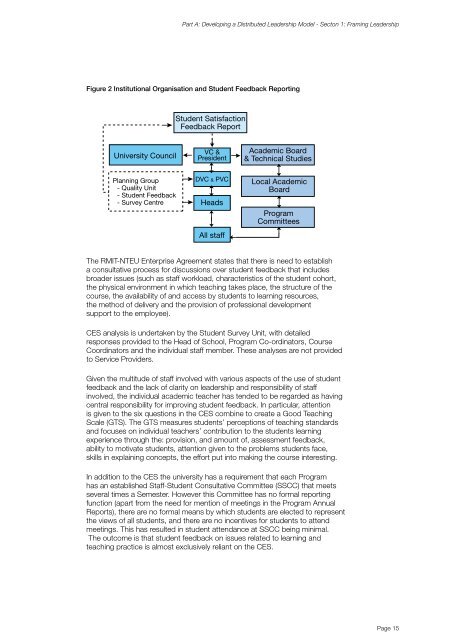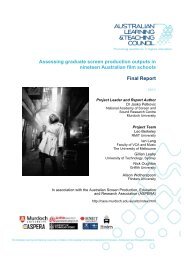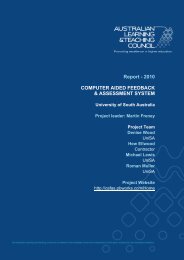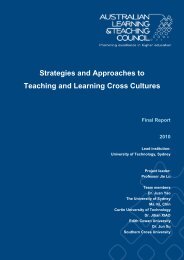student feedback and leadership - Office for Learning and Teaching
student feedback and leadership - Office for Learning and Teaching
student feedback and leadership - Office for Learning and Teaching
You also want an ePaper? Increase the reach of your titles
YUMPU automatically turns print PDFs into web optimized ePapers that Google loves.
Part A: Developing a Distributed Leadership Model - Secton 1: Framing LeadershipFigure 2 Institutional Organisation <strong>and</strong> Student Feedback ReportingStudent SatisfactionFeedback ReportUniversity CouncilVC &PresidentAcademic Board& Technical StudiesPlanning Group- Quality Unit- Student Feedback- Survey CentreDVC & PVCHeadsAll staffLocal AcademicBoardProgramCommitteesThe RMIT-NTEU Enterprise Agreement states that there is need to establisha consultative process <strong>for</strong> discussions over <strong>student</strong> <strong>feedback</strong> that includesbroader issues (such as staff workload, characteristics of the <strong>student</strong> cohort,the physical environment in which teaching takes place, the structure of thecourse, the availability of <strong>and</strong> access by <strong>student</strong>s to learning resources,the method of delivery <strong>and</strong> the provision of professional developmentsupport to the employee).CES analysis is undertaken by the Student Survey Unit, with detailedresponses provided to the Head of School, Program Co-ordinators, CourseCoordinators <strong>and</strong> the individual staff member. These analyses are not providedto Service Providers.Given the multitude of staff involved with various aspects of the use of <strong>student</strong><strong>feedback</strong> <strong>and</strong> the lack of clarity on <strong>leadership</strong> <strong>and</strong> responsibility of staffinvolved, the individual academic teacher has tended to be regarded as havingcentral responsibility <strong>for</strong> improving <strong>student</strong> <strong>feedback</strong>. In particular, attentionis given to the six questions in the CES combine to create a Good <strong>Teaching</strong>Scale (GTS). The GTS measures <strong>student</strong>s’ perceptions of teaching st<strong>and</strong>ards<strong>and</strong> focuses on individual teachers’ contribution to the <strong>student</strong>s learningexperience through the: provision, <strong>and</strong> amount of, assessment <strong>feedback</strong>,ability to motivate <strong>student</strong>s, attention given to the problems <strong>student</strong>s face,skills in explaining concepts, the ef<strong>for</strong>t put into making the course interesting.In addition to the CES the university has a requirement that each Programhas an established Staff-Student Consultative Committee (SSCC) that meetsseveral times a Semester. However this Committee has no <strong>for</strong>mal reportingfunction (apart from the need <strong>for</strong> mention of meetings in the Program AnnualReports), there are no <strong>for</strong>mal means by which <strong>student</strong>s are elected to representthe views of all <strong>student</strong>s, <strong>and</strong> there are no incentives <strong>for</strong> <strong>student</strong>s to attendmeetings. This has resulted in <strong>student</strong> attendance at SSCC being minimal.The outcome is that <strong>student</strong> <strong>feedback</strong> on issues related to learning <strong>and</strong>teaching practice is almost exclusively reliant on the CES.Page 15
















